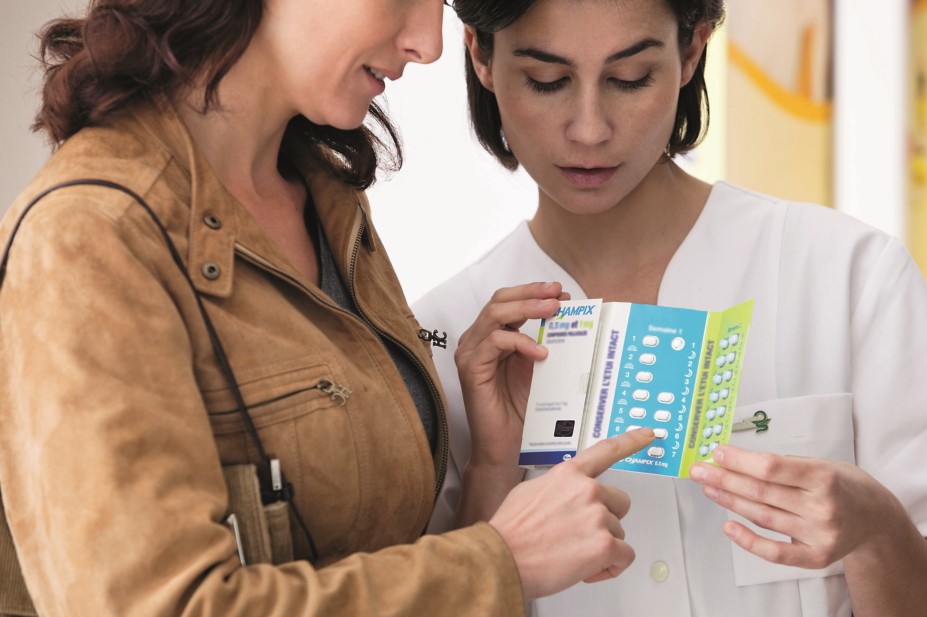
BSIP SA / Alamy Stock Photo
Tobacco is the only legal drug that kills many of its users when used exactly as was intended and directed by manufacturers. The World Health Organization (WHO), an agency of the United Nations concerned with international public health, has estimated that tobacco use (smoking and smokeless) is currently responsible for the death of around six million people worldwide each year, which also includes around 600,000 people who are estimated to die from the effects of second-hand smoke[1]
.
Smoking is the primary cause of preventable ill health and death in the UK[2]
. In 2015, around 100,000 deaths were attributable to smoking in the UK[3]
. On average, although deaths estimated to be attributable to smoking in England are falling[4]
, smoking still places a significant demand on the Health and Social Care services across community, primary and secondary care. In England, for example, it costs the NHS around £2 billion per year to treat diseases caused by smoking[2]
.
According to data from 2016, around 7.6 million people in the UK smoke (15.8% of the population). Of the constituent countries, 15.5%, 16.9%, 17.7% and 18.1% of adults in England, Wales, Scotland and Northern Ireland, respectively, smoke. Exposure to second-hand smoke can also lead to a range of diseases, many of which are fatal, with children especially vulnerable to the effects of passive smoking (see Box 1: ‘Effects of second-hand smoke’)[3]
. Therefore, a main objective for the government and devolved administrations is reducing the prevalence of cigarette smoking[5],[6],[7],[8]
. As community pharmacies are often people’s first point of contact with health services, pharmacists and the pharmacy team are ideally placed to support and refer smokers who want to stop. This article aims to describe how nicotine replacement therapy (NRT) and counselling in a pharmacy setting can help patients quit smoking.
Box 1: Effects of second-hand smoke
Breathing other people’s tobacco smoke can cause ill health in people who do not smoke. Second-hand smoke has been shown to cause:
- Lung cancer and heart disease in adult non-smokers;
- Increased sensitivity and reduced lung function in people with asthma;
- Irritation of the eye, nose and throat;
- Reduced lung function in adults with no chronic chest problems.
Babies and children exposed to second-hand smoke are at:
- An increased risk of respiratory infections;
- An increased severity of asthma symptoms;
- More frequent occurrence of chronic coughs, phlegm and wheezing;
- An increased risk of cot death and glue ear.
Pregnant women who are exposed to second-hand smoke are:
- At an increased risk of pre-term birth;
- More likely to have a baby with reduced foetal growth.
Sources:
Action on Smoking and Health. Facts at a Glance. Smoking and Disease June 2016. Available at: http://ash.org.uk/information-and-resources/fact-sheets/smoking-and-disease/ (accessed September 2017)
National Institute for Health and Care Excellence (NICE). Public Health guideline [PH10]. Stop smoking services. Available at: https://www.nice.org.uk/guidance/ph10/chapter/2-Public-health-need-and-practice (accessed September 2017)
Why is it hard to quit?
Tobacco in its raw form is a harsh substance; it is hard to inhale deeply and not especially addictive. However, the tobacco industry has refined the product so that now most smokers use the product every day and find it very hard to quit.
The reasons that cigarette smoking is so highly addictive are thought to be threefold:
- Pleasure — nicotine affects the dopamine pathway in the brain, making smoking a pleasurable thing to do. For some people this turns into a dependence; their natural dopamine levels decrease and they need to keep smoking to maintain normal brain chemistry[9]
; - Behavioural aspects — smoking becomes a habit and an integral part of the daily ritual. This is particularly hard to break because the brain associates the chemical pleasure of dopamine release from smoking a cigarette with everyday actions (e.g. finishing a meal or work for the day). The enforced isolation of the smoker is often used as ‘my time’ or as a series of ‘mindful’ pauses throughout the day;
- Environmental triggers — smokers’ brains know that smoking a cigarette will stimulate their pleasure pathways, and visual and other stimuli make them crave a cigarette. The simple act of seeing someone else smoking, or even just seeing a cigarette, can trigger this[10]
.
Consequently, a successful smoking cessation programme needs to address all the above.
Smoking cessation
The long-term quit rate of smokers who do not participate in a smoking cessation programme is less than 5%[11]
. However, with support in the form of group sessions or other counselling, the success rate greatly increases, with many areas having carbon monoxide (CO)-validated four-week success rates of more than 50%[12]
.
Providing brief unsolicited advice
Pharmacists and healthcare professionals should enquire on the smoking status of their patients at least once a year. They should raise smoking status as a matter of course during routine consultations with patients and smokers, whether they are seeking help with stopping smoking or not.
Pharmacists have unique opportunities to provide brief advice to patients, outside of smoking cessation services, including during the purchase of over-the-counter medicines, through medicines use reviews, or during local or national campaigns (e.g. No Smoking Day).
The key elements of brief smoking cessation advice are:
- Ask the patient if they smoke;
- Advise them to quit;
- If they would like to quit smoking, provide assistance by referring them to the NHS stop-smoking service, or if they do not want to attend the service, provide an alternative.
Smoking cessation services
NHS smoking cessation services are co-ordinated centrally in each of the UK’s constituent countries; NHS services in England are covered by NHS Smokefree, NHS Inform in Scotland, Want 2 Stop in Northern Ireland and Help Me Quit in Wales[13],[14],[15],[16]
. These centres signpost smokers towards the most appropriate service to help in their quit attempt, for example a local smoking cessation group or one-to-one sessions, telephone consultations, a community pharmacy or a hospital-based service.
There are different types of stop-smoking services that are either commissioned individually or combined into a single service[17]
. These include:
- Nicotine replacement therapy (NRT) voucher service. Pharmacy staff can supply NRT when presented a voucher issued by the local stop-smoking service. The pharmacy team would ensure the NRT product is suitable for the patient based on their smoking status and lifestyle, and continue to ensure the NRT product is suitable on dispensing. Ongoing stop-smoking support is provided by the local stop smoking service;
- Stop smoking support service — supply of NRT. Pharmacy staff trained as stop-smoking advisers to provide support to individuals or groups. A number of weekly sessions could be offered, for example, for 6 or 12 weeks, to monitor the individual’s progress and supply appropriate NRT products;
- Varenicline or bupropion voucher service. Pharmacists could supply either of the prescription-only medicines (POM) bupropion or varenicline, under a Patient Group Direction (PGD) when presented with a valid voucher issued by the local stop-smoking service. The pharmacist will carry out a clinical check to ensure the medicine is suitable for the patient and decide whether a supply can be made. Ongoing stop-smoking support will be provided by the local stop-smoking service;
- Stop-smoking support service — supply of NRT, varenicline or bupropion. Pharmacy staff trained as stop-smoking advisers to provide support to individuals or groups. A number of weekly sessions could be offered, for example, for 6 or 12 weeks, to monitor the individual’s progress and appropriate NRT products could be supplied. Pharmacists are able to supply the POMs varenicline and/or bupropion under PGD to patients who would be more suited to this treatment than to NRT.
Private services, such as acupuncture and hypnotherapy, are commonly available. However, there is very little reliable information regarding the quit rates of patients using these services.
Community pharmacy-based smoking cessation services
Most areas of the UK have commissioned a community pharmacy-based smoking cessation service. This service has the advantages of accessible locations and opening times, offering a one-to-one consultation, as well as a ‘one-stop-shop’, providing both counselling and NRT products.
Nicotine replacement therapy
There are many pharmacological products available to support patients in quitting, and evidence shows that dual therapy (using a combination of NRT products) leads to more successful outcomes than treatment with a single product[18]
. NRT can work in one of two ways: slower-release products (e.g. patches) that deliver a baseline amount of nicotine to help with the background craving; or faster-acting products (e.g. inhalators, sprays, lozenges, gum) that deliver nicotine quickly to help combat episodic cravings caused by chemical triggers in the brain as a result of habitual or environmental triggers. Table 1 provides more detailed information about the variety of NRT products available.
The following considerations are important to best support patients in quitting smoking by using NRT:
- Assessing the patient’s readiness and ability to quit, including their current smoking and any past attempts to quit. It is also important to discuss potential nicotine withdrawal symptoms;
- Agreeing the most appropriate products with the patient;
- Using dual therapy — it pays to ‘go big’ with NRT early on because it reduces the withdrawal symptoms and makes the quit attempt more likely to succeed (see Box 2: ‘Side effect or withdrawal symptom?’). Most quit attempts that fail, fail in the first week;
- Being flexible — many patients feel the need to switch from a particular product and benefit from changing their immediate-release nicotine device (e.g. from a spray to a lozenge).
Pharmacists should be mindful that stopping smoking usually brings on a withdrawal syndrome comprising a range of symptoms (see Box 2). These symptoms, especially urges to smoke, can lead to relapse early in a quit attempt. Most withdrawal symptoms last no longer than two to four weeks, so assisting smokers with both counselling and NRT products during the first four weeks is important.
Box 2: Side effect or withdrawal symptom?
As part of the counselling session, pharmacists should discuss the potential withdrawal symptoms following smoking cessation, as well as the possible side effects of nicotine replacement therapy.
Listed side effect:
- Sleep disturbance;
- Nausea;
- Headache;
- Dizziness;
- Sore throat;
- Cough;
- Skin reactions;
- Mouth ulcers;
- Heartburn.
Known nicotine withdrawal symptoms:
- Sleep disturbance;
- Nausea;
- Headache;
- Dizziness;
- Cough;
- Mouth ulcers.
Cautions for NRT use
All NRT should be used with caution in patients with underlying cardiovascular disease, diabetes mellitus, gastrointestinal disease, renal or hepatic impairment, and uncontrolled hyperthyroidism. In almost all instances, however, the risk associated with NRT will be outweighed by the benefit of stopping smoking.
In pregnant patients, an intermittent form of NRT would be preferable. Unfortunately, sometimes the nausea associated with early pregnancy makes patches the most realistic option[19]
. In this instance, patches should be removed before going to bed[20]
. In any event, the expectant mother stopping smoking will be the most beneficial to the unborn child.
| NRT product | Indication | Instructions for use | Side effects | Additional cautions | Approximate cost per week (£) |
|---|---|---|---|---|---|
| Patches | Background craving | 16- or 24-hour patches available. Apply in the morning and either remove 1 hour before bed or leave on 24 hours. Rotate site of application | Skin reaction, sleep disturbance (especially vivid dreams) and see Box 2 | Pregnancy, dermatological conditions | 10 |
| Inhalator | Episodic craving, especially useful for when something tactile is required and continued hand-to-mouth action is beneficial | For best effect, absorb through buccal mucosa, not drawn down to lungs, each cartridge lasts for about 40 minutes of use. Use up to 6 cartridges in 24 hours | See Box 2 | N/A | 25 |
| Oral spray | Episodic craving, a degree more clinical than the inhalator. Moves away from hand to mouth | Spray into side of mouth, do not swallow. For monotherapy use up to 4 sprays an hour, 64 sprays in 24 hours; less if used with patch | See Box 2 | Gastrointestinal (GI) disease | 12 |
| Lozenge/microtab | Episodic craving, discrete, slow release of nicotine | Absorbed through buccal mucosa. Allow to dissolve in mouth, do not swallow. Max 15 lozenges in 24 hours | Hiccups if used incorrectly and see Box 2 | GI disease | 8 |
| Gum | Episodic craving, tricky to use correctly but still requested | Chew slowly until taste becomes strong then stop chewing and place (park) the gum between the cheek and the gum; chew again when taste has gone. Max 15 gums in 24 hours | Hiccups, nausea, sore mouth | GI disease | 10 |
| Nasal spray | Episodic craving, works very quickly but side effects have limited its appeal | Spray into nose, correct technique is very important | Side effects are particularly prevalent during the first two days of use and include sneezing, runny nose, watering eyes and cough | GI disease | 15 |
Counselling
A typical community pharmacy-based smoking cessation programme will include a number of one-to-one consultations, often based on motivational interviewing or brief intervention techniques. It is common for there to be weekly sessions for four or five weeks and then fortnightly meetings until the programme finishes, which is usually three months in duration. This format allows the patient to discuss things in a non-judgmental, non-demoralising environment and is crucial to the high success rate of the service.
Vaping
Swapping from cigarette smoking to vaping is better for the individual’s health[21],[22]
, although the effects of long-term use are unknown. Consequently, e-cigarettes are not currently licensed for smoking cessation and National Institute of Health and Care Excellence (NICE) guidance advises that there is little evidence on the long-term benefits or harms of e-cigarettes[23]
.
How pharmacists can support people trying to quit
Pharmacists are ideally placed to advise patients on how to stop smoking and to provide information on the supply of medication. Consequently, they need to be aware of the variety of NRT available (see Table 1) and the potential pitfalls patients might face when attempting to quit; this information should be given to patients verbally and in written format. In community pharmacy, the combination of NRT, to reduce the symptoms of withdrawal, and counselling patients, to help them address some of the habitual issues, has a healthy success rate[24],[25],[26],[27]
. It is hoped that such services will create a healthier and longer-living population.
Useful resources:
- NHS smoke free campaign
- National Centre for Smoking Cessation and Training
- Action on Smoking and Health
- National Institute for Health and Care Excellence (NICE)
Reading this article counts towards your CPD
You can use the following forms to record your learning and action points from this article from Pharmaceutical Journal Publications.
Your CPD module results are stored against your account here at The Pharmaceutical Journal. You must be registered and logged into the site to do this. To review your module results, go to the ‘My Account’ tab and then ‘My CPD’.
Any training, learning or development activities that you undertake for CPD can also be recorded as evidence as part of your RPS Faculty practice-based portfolio when preparing for Faculty membership. To start your RPS Faculty journey today, access the portfolio and tools at www.rpharms.com/Faculty
If your learning was planned in advance, please click:
If your learning was spontaneous, please click:
References
[1] World Health Organization (WHO). WHO global report on trends in prevalence of tobacco smoking 2015. Available at: http://apps.who.int/iris/bitstream/10665/156262/1/9789241564922_eng.pdf (accessed January 2018)
[2] Action on Smoking and Health. Fact sheets. Available at: http://ash.org.uk/category/information-and-resources/fact-sheets/ (accessed January 2018)
[3] Office for National Statistics. Adult smoking habits in the UK: 2016. Available at: https://www.ons.gov.uk/peoplepopulationandcommunity/healthandsocialcare/healthandlifeexpectancies/bulletins/adultsmokinghabitsingreatbritain/2016 (accessed January 2018)
[4] NHS Digital. Statistics on smoking England 2017. Available at: https://digital.nhs.uk/catalogue/PUB24228 (accessed January 2018)
[5] HM Government. Healthy lives healthy people – a tobacco control plan for England 2011. Available at: https://www.gov.uk/government/uploads/system/uploads/attachment_data/file/213757/dh_124960.pdf (accessed January 2018)
[6] Welsh Government. A tobacco control action plan for Wales 2012. Available at: http://gov.wales/docs/phhs/publications/120202planen.pdf (accessed January 2018)
[7] Department of Health, Social Services and Public Safety. Ten-year tobacco control strategy for NI. 2012. Available at: https://www.health-ni.gov.uk/sites/default/files/publications/dhssps/tobacco-control-10-year-strategy.pdf (accessed January 2018)
[8] Scottish Government. Creating a tobacco-free generation – a tobacco control strategy for Scotland. 2013. Available at: http://www.gov.scot/Resource/0041/00417331.pdf (accessed January 2018)
[9] Benowitz NL. Nicotine addiction. N Engl J Med 2010;362(24):2295–2303. doi: 10.1056/NEJMra0809890
[10] Mogg K, Bradley BP, Field M et al. Eye movements to smoking-related pictures in smokers: relationship between attentional biases and implicit and explicit measures of stimulus valence. Addiction 2003;98(6):825–836. doi: 10.1046/j.1360-0443.2003.00392.x
[11] Hughes JR, Keely J & Naud S. Shape of the relapse curve and long-term abstinence among untreated smokers. Addiction 2004;99(1):29–38. doi: 10.1111/j.1360-0443.2004.00540.x
[12] Bauld L, Bell K, McCullough L et al. The effectiveness of NHS smoking cessation services: a systematic review. J Public Health 2009:1–12. doi: 10.1093/pubmed/fdp074
[13] NHS Smokefree. Available at: https://www.nhs.uk/smokefree (accessed January 2018)
[14] NHS Inform. Available at: https://www.nhsinform.scot (accessed January 2018)
[15] Want 2 Stop. Available at: http://www.want2stop.info/ (accessed January 2018)
[16] Help Me Quit. Available at: www.helpmequit.wales/quit/smoking (accessed January 2018)
[17] Think Pharmacy. Stop smoking service. Available at: http://psnc.org.uk/wp-content/uploads/2013/07/Stop-smoking-May-2016.pdf (accessed January 2018)
[18] Stead LF, Perera R, Bullen C et al. Nicotine replacement therapy for smoking cessation. Cochrane Database Syst Rev 2008;(1):CD000146. doi: 10.1002/14651858.CD000146.pub3
[19] NHS Choices. Stop smoking in pregnancy. Available at: https://www.nhs.uk/conditions/pregnancy-and-baby/pages/smoking-pregnant.aspx (accessed January 2018)
[20] National Institute for Health and Care Excellence. Public health guideline [PH10] Stop smoking services. Available at: https://www.nice.org.uk/guidance/ph10/chapter/4-Recommendations (accessed January 2018)
[21] Bullen C, López-Núñez C & Knight-West O. E-cigarettes in smoking cessation: a harm reduction perspective. Clinical Pharmacist 8(4). doi: 10.1211/CP.2016.20200851
[22] Public Health England. E-cigarettes: an evidence update. A report commissioned by Public Health England. Available at: https://www.gov.uk/government/uploads/system/uploads/attachment_data/file/457102/Ecigarettes_an_evidence_update_A_report_commissioned_by_Public_Health_England_FINAL.pdf (accessed January 2018)
[23] National Institute for Health and Care Excellence. Public health guideline [PH45]. Smoking: harm reduction. Available at: https://www.nice.org.uk/guidance/ph45/chapter/9-the-evidence (accessed January 2018)
[24] Brown TJ, Todd A, O’Malley C et al. Community pharmacy-delivered interventions for public health priorities: a systematic review of interventions for alcohol reduction, smoking cessation and weight management, including meta-analysis for smoking cessation. BMJ Open 2016;6:e009828. doi: 10.1136/bmjopen-2015-009828
[25] Information Services Division. NHS smoking cessation service statistics (Scotland) 1st April 2011 to 31st March 2013. Available at: https://isdscotland.scot.nhs.uk/Health-Topics/Public-Health/Publications/2013-09-24/2013-09-24-smoking-cessation-monitoring-report.pdf?76417177916 (accessed January 2018)
[26] Stats Wales. Welsh resident smokers treated and CO-validated as successfully quitting at 4 weeks, by local health board, service and individual quarter. Available at: https://statswales.gov.wales/Catalogue/Health-and-Social-Care/NHS-Performance/smoking-cessation-services/welshresidenttreatedsmokerswhocovalidatedsuccessfullyquitting4weeks-by-lhb-service-individualquarter (accessed January 2018)
[27] NHS Digital. Statistics on NHS stop smoking services: England, April 2015 to March 2016. Available at: http://digital.nhs.uk/catalogue/PUB21162 (accessed January 2018)
You might also be interested in…

Smoking cessation medicine cytisine to be available in January 2024, distributor confirms

Scottish government considers nicotine addiction treatment for children aged under 12 years
